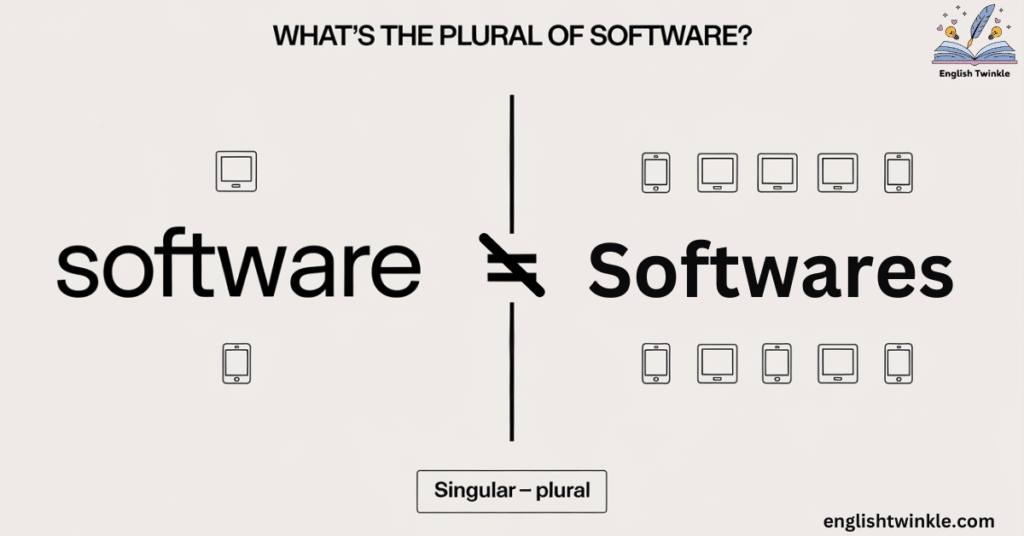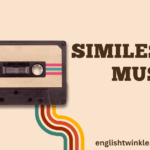In the ever-evolving world of technology, language often struggles to keep pace. One such linguistic puzzle that’s been baffling tech enthusiasts and grammar aficionados alike is the question of the plural of software. Is it “software” or “softwares”? Let’s dive deep into this digital dilemma and shed some light on the correct usage, alternatives, and the fascinating history behind this ubiquitous term.
Decoding the Definition: What Exactly is Software?
Before we tackle the plural puzzle, let’s establish a clear understanding of what software actually means.
Software refers to a set of instructions, data, or programs used to operate computers and execute specific tasks. Unlike hardware, which refers to the physical components of a computer system, software is intangible and exists in the form of code and data.
Here’s a quick breakdown of the key aspects of software:
- It’s a set of instructions for a computer
- It’s intangible (you can’t physically touch it)
- It’s essential for operating computer systems and performing tasks
- It comes in various types and forms
Types of Software
To better grasp the concept, let’s look at the main types of software:
- System Software: Manages and controls computer hardware (e.g., operating systems like Windows or macOS)
- Application Software: Performs specific tasks for users (e.g., word processors, web browsers)
- Programming Software: Used to write, develop, test, and debug other software programs (e.g., compilers, debuggers)
Software Terminology Table
Here’s a table to help clarify some common software-related terms:
| Term | Definition | Example |
|---|---|---|
| Software | Set of instructions for a computer | Microsoft Word |
| Program | A specific piece of software | Photoshop |
| Application | Software designed for end-users | Gmail |
| Operating System | Software that manages hardware and provides services for other software | Windows 10 |
| Source Code | The human-readable form of software | C++ code files |
| Algorithm | A step-by-step procedure for solving a problem or performing a task | Sorting algorithm |
| Interface | The point of interaction between software and its users | Graphical User Interface (GUI) |
The Grammatical Breakdown: Software as a Mass Noun
Now that we’ve established what software is, let’s delve into its grammatical nature. The key to understanding why “softwares” is incorrect lies in recognizing that software is a mass noun.
What’s a Mass Noun?
A mass noun, also known as an uncountable noun, refers to something that can’t be counted as separate elements. These nouns don’t have a plural form and are always treated as singular such as the plural of software.
Here’s a table comparing some common mass nouns with countable nouns:
| Mass Nouns | Countable Nouns |
|---|---|
| Water | Cup |
| Rice | Grain |
| Information | Fact |
| Software | Program |
| Knowledge | Idea |
| Music | Song |
| Equipment | Tool |
Just as you wouldn’t say “informations” or “rices,” you shouldn’t say “softwares.”
Mass Nouns in Technology
The tech world is full of mass nouns. Here are some examples:
- Hardware
- Firmware
- Malware
- Freeware
- Shareware
- Spyware
- Bandwidth
All these terms follow the same rule as software – they don’t have a plural form and are always used in the singular.
The Singular Form: Correct Usage of “Software”
When using “software” in a sentence, always treat it as singular. Here are some examples of correct usage:
- The software is running smoothly.
- This new software has revolutionized our workflow.
- We need to update the software to the latest version.
“Software is like entropy. It is difficult to grasp, weighs nothing, and obeys the second law of thermodynamics; i.e. it always increases.” – Norman Ralph Augustine
Industry Standards and Style Guides
Major tech companies and style guides consistently use “software” in its singular form. For instance:
- Microsoft: “Microsoft software includes computer software, mobile software, server software, and cloud-based software.”
- Apple: “Apple’s software is designed to work together seamlessly.”
- The Associated Press Stylebook: “Software is singular: The software is user-friendly.”
The Misused Plural: Why “Softwares” is Incorrect
Despite its widespread misuse, “softwares” is grammatically incorrect. This error often stems from:
- Non-native English speakers applying regular pluralization rules
- Regional dialects or colloquialisms
- Confusion due to the multiple types and pieces of software that exist
Remember, even when referring to multiple software programs or applications, the term remains “software” as it the plural from of software.
Common Mistakes Table
| Incorrect Usage | Correct Usage |
|---|---|
| We need to install new softwares. | We need to install new software. |
| The company develops various softwares. | The company develops various software programs. |
| Which softwares do you use? | Which software do you use? |
| They offer three different softwares. | They offer three different software packages. |
Here’s a table illustrating common mistakes and their corrections:
Alternatives to “Softwares”: Expressing Plurality

While we can’t use “softwares,” there are many ways to express plurality when talking about multiple software programs or applications. Here are some alternatives:
- Software programs
- Software applications
- Pieces of software
- Software solutions
- Software packages
- Software tools
For example:
- “We use various software programs in our daily operations.”
- “The company develops multiple pieces of software for different industries.”
Synonyms and Alternatives Table
Here’s a table of synonyms and alternatives for “software” in different contexts:
| Context | Synonyms/Alternatives |
|---|---|
| General | Computer programs, Applications, Digital tools |
| Business | Software solutions, Enterprise software, Business applications |
| Development | Code, Source code, Programming tools |
| System | Operating system, Platform, Environment |
| Mobile | Apps, Mobile applications, Mobile software |
The Etymology of “Software”: A Journey Through Time
The term “software” has an interesting origin story that dates back to the early days of computing. Let’s explore its evolution:
- 1953: The term “software” first appeared in print in a paper by statistician John W. Tukey.
- 1958: John W. Tukey used the term again in an article in American Mathematical Monthly.
- 1960s: The term gained widespread use in the computing industry.
“Software comes from heaven when you have good hardware.” – Ken Olsen, founder of Digital Equipment Corporation
The word “software” was coined as a play on the term “hardware,” which was already in use to describe physical equipment. The “soft” in software emphasizes its intangible nature compared to the “hard” physical components.
Evolution of Software: A Timeline
| Year | Event |
|---|---|
| 1948 | First stored program computer, the Manchester Baby, runs |
| 1950s | Assembly languages developed |
| 1957 | FORTRAN, the first high-level programming language, is created |
| 1960s | BASIC and COBOL languages developed |
| 1970s | C programming language created |
| 1980s | Microsoft Windows and Apple Macintosh introduce GUIs |
| 1990s | World Wide Web and internet software boom |
| 2000s | Mobile apps and cloud computing emerge |
| 2010s | AI and machine learning software becomes mainstream |
Similar Mass Nouns in Technology
Software isn’t the only mass noun in the tech world. Here are some others:
- Hardware: The physical components of a computer system
- Firmware: Software that’s embedded in a hardware device
- Malware: Malicious software designed to damage or disrupt computer systems
- Freeware: Software that’s available for use at no cost
Like software, these terms don’t have plural forms and are always used in the singular.
Global Perspectives: Software Across Languages
The usage of “software” varies across different languages and cultures. Here’s a glimpse into how other languages handle this term:
| Language | Term for Software | Plural Form |
|---|---|---|
| French | Le logiciel | Les logiciels |
| German | Die Software | No plural |
| Spanish | El software | No official plural |
| Japanese | ソフトウェア (sofutowea) | No plural |
| Chinese | 软件 (ruǎnjiàn) | No plural |
| Russian | Программное обеспечение (programmnoye obespecheniye) | No plural |
| Italian | Il software | I software (rare) |
| Portuguese | O software | Os softwares (colloquial) |
This global variation highlights the challenges of standardizing tech terminology across languages and cultures.
The Great Debate: Prescriptivism vs. Descriptivism
The “software vs. softwares” debate touches on a larger linguistic discussion: prescriptivism versus descriptivism.
- Prescriptivists argue for adherence to established grammatical rules, insisting on “software” as the only correct form.
- Descriptivists might argue that if “softwares” becomes widely used, it could eventually be accepted as correct.
However, in professional and technical contexts, using “software” as a mass noun remains the standard and most widely accepted practice.
Prescriptivism vs. Descriptivism: Key Points
| Aspect | Prescriptivism | Descriptivism |
|---|---|---|
| Approach to rules | Advocates for strict adherence to established rules | Observes and describes language as it’s actually used |
| Focus on usage | Emphasizes “correct” usage | Recognizes evolving usage patterns |
| Attitude toward standards | Maintains language standards | Acknowledges language change over time |
| Potential criticism | Can be seen as inflexible | Can be seen as too permissive |
Real-world Implications: Why Correct Usage Matters
Using “software” correctly isn’t just about grammar; it has real-world implications:
- Technical Writing: Proper usage ensures clear, professional documentation.
- SEO: Correct terminology improves search engine optimization for tech companies.
- Legal Language: Precise language is crucial in contracts and legal documents.
- International Communication: Standardized usage facilitates clearer global communication in the tech industry.
Case Study: The Importance of Precise Language in Software Contracts

In 2017, a major software company faced a lawsuit due to ambiguous language in their licensing agreement. The dispute centered around the term “software,” which was not clearly defined in the contract. The company had intended it to cover all their products, while the client interpreted it as referring to a specific program.
This case highlights the critical importance of using precise, standardized language when discussing software in legal and business contexts. It led to significant financial losses and a revision of the company’s contract templates to ensure clarity in future agreements.
Looking to the Future: The Evolution of Tech Language
As technology continues to advance at a rapid pace, so too does the language we use to describe it. While “software” remains a mass noun for now, it’s possible that usage could evolve in the future.
Emerging trends in tech language include:
- Increasing use of acronyms (SaaS, IoT, AI)
- Blend words (DevOps, FinTech)
- Repurposing of existing words (cloud, agile)
The role of AI in language evolution is also worth considering. As AI becomes more integrated into our daily lives, it may influence how we talk about software and other tech concepts.
Future Tech Terms: Predictions
| Current Term | Potential Future Evolution |
|---|---|
| Software | Might split into more specific categories (e.g., AIware, Bioware) |
| App | Could evolve to cover more types of digital experiences |
| Code | Might be replaced as AI-driven no-code solutions become more prevalent |
| Interface | Could expand to include brain-computer interfaces and other advanced interaction methods |
The Importance of Software in Modern Society

As we discuss the linguistics of “software,” it’s crucial to recognize its fundamental importance in our daily lives. Software has become an integral part of modern society, powering everything from smartphones to space exploration.
Key Areas Impacted by Software
- Communication: Email, messaging apps, social media
- Business: Enterprise resource planning, customer relationship management
- Education: E-learning platforms, educational apps
- Healthcare: Electronic health records, diagnostic tools
- Entertainment: Streaming services, video games
- Transportation: GPS navigation, ride-sharing apps
- Finance: Online banking, cryptocurrency
The pervasive nature of software underscores the importance of using correct terminology when discussing it. Clear communication about software is essential for technological progress, business success, and societal advancement.
Conclusion: The Verdict on “Software”
After this deep dive into the world of software and grammar, the verdict is clear: “software” is the correct form for both singular and plural usage. As a mass noun, it doesn’t have a plural form, and “softwares” is grammatically incorrect.
To recap the key points:
- Software is a mass noun, like water or information
- Use “software” for both singular and plural contexts
- When specificity is needed, use phrases like “software programs” or “pieces of software”
- Correct usage matters for clear communication in the tech world
By understanding and using “software” correctly, we can communicate more clearly and professionally in the ever-evolving world of technology. Remember, in the realm of bytes and algorithms, precision in language is just as important as precision in code.
Additional Resources
For those eager to dive deeper into tech terminology and writing, here are some valuable resources:
- Microsoft Style Guide
- Apple Style Guide
- Google Developer Documentation Style Guide
- IEEE Computer Society Style Guide
These guides offer comprehensive advice on tech writing, including proper usage of terms like “software.” Happy writing, and may your software always run smoothly!

Freck John, linguist and English educator, shares grammar insights and writing tips at English Twinkle, making language concepts accessible to all learners.







